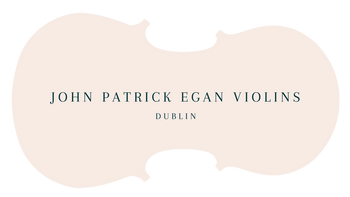Top 5 Mistakes People Make When Selling a Violin
By John Patrick Egan Violins, Dublin
If you're thinking about selling a violin—whether it’s a family heirloom, a student instrument, or an antique—you may be surprised at how many pitfalls there are along the way. Over the years, we’ve seen well-meaning sellers lose out on value, attract the wrong buyers, or even damage a rare instrument’s reputation with one wrong move.
To help you avoid the most common missteps, here are the top five mistakes people make when selling a violin, and what to do instead.
1. Relying on the Label Alone
Just because the label inside says “Stradivarius” or “Made in Italy 1741” doesn’t mean it’s genuine. Many violins—especially factory-made ones from the 19th and early 20th centuries—have misleading or decorative labels that don't reflect the instrument’s true origin or value.
What to do instead:
Have the violin professionally examined. An experienced appraiser can determine whether the label is authentic or ornamental, and give you a realistic understanding of the instrument’s background.
2. Skipping a Professional Valuation
Selling a violin without knowing its fair market value is like selling a house without an estate agent’s input. You risk pricing it far too low—or too high, scaring off serious buyers.
What to do instead:
Book a valuation with a reputable violin expert. At John Patrick Egan Violins, we provide written valuations for resale, insurance, or auction purposes, giving you a solid foundation to move forward.
3. Trying to Sell on General Marketplaces
Websites like eBay, Gumtree, or Facebook Marketplace may seem convenient, but they rarely attract knowledgeable buyers. Worse, they can expose you to low offers, scams, or shipping damage from poorly packed instruments.
What to do instead:
Work with a violin specialist who understands the market, has access to the right buyers, and can handle presentation, negotiation, and secure delivery.
4. Overlooking Condition Issues
Loose seams, open cracks, or a warped bridge may seem minor, but they can seriously affect a violin’s playability—and value. Many sellers don’t realise how much these issues matter to buyers.
What to do instead:
Have the instrument evaluated for possible repairs or setup adjustments. Sometimes, small investments in restoration can lead to a much better sale price, especially if the violin is of fine quality.
5. Selling Without Proper Documentation
A verbal promise or a quick estimate won’t give the buyer confidence—or protect you if there’s a dispute later. Lack of paperwork can also lower the perceived value of the instrument.
What to do instead:
Whenever possible, provide a formal valuation, repair history, and any relevant provenance. If you work with us on consignment or at auction, we handle all of this for you.
Thinking of Selling a Violin?
At John Patrick Egan Violins, we help owners sell their instruments with honesty, transparency, and care—whether it’s through private sale, consignment, or auction. Our goal is to ensure your violin finds the right home, and that you receive fair value for what you have.
Visit our Dublin office
Call +353 (0)87 000 2167
Email johnpatrickeganviolins@gmail.com to book a valuation or selling consultation
